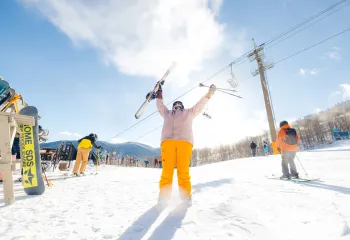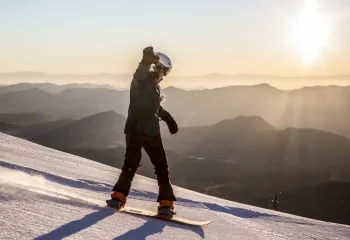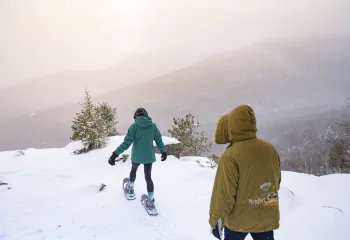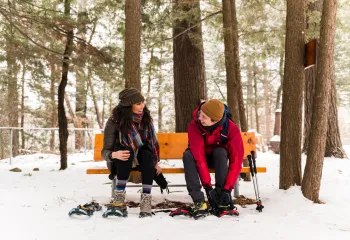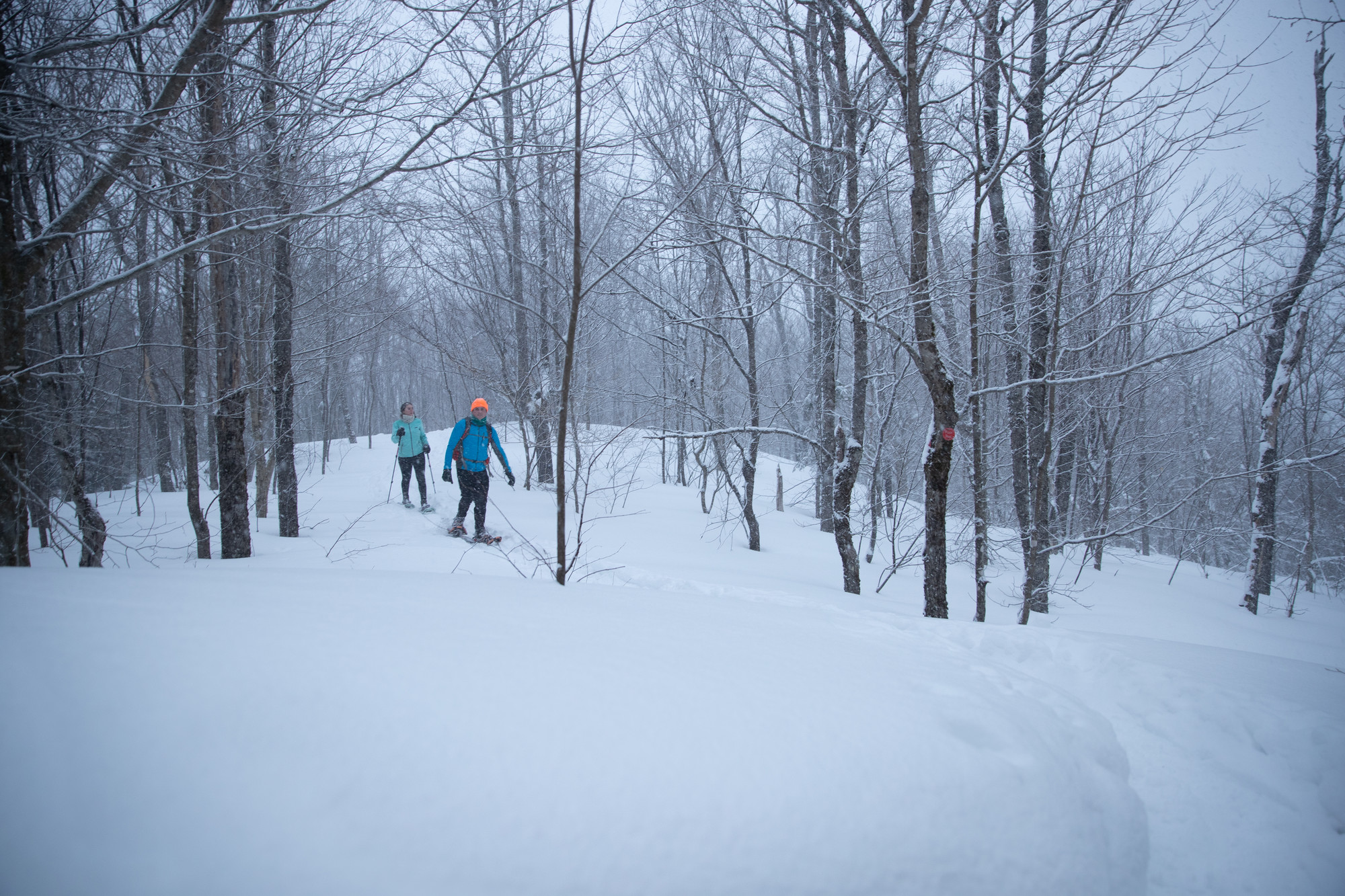
Submitted by guest blogger Eileen Mowrey
The thought of hiking usually brings to mind buggy summer days and scenic fall foliage, but winter hiking is great, too! In fact, it’s one of the most epic winter activities you can experience in the Adirondacks – so long as you come prepared.
While the Whiteface Region is full of winter hiking options just waiting to be explored, no winter hike should be attempted without the proper gear and knowledge. As fun as winter hiking is – and I promise, it is fun – the stakes are higher than in other seasons. Cold weather and difficult conditions require additional effort, both before and during your hike. Before you set off for that snow-covered peak, prepare for your winter hike by following these four tips.

1. Plan ahead and prepare
When it comes to winter hiking, there is one word that simply cannot be said enough – prepare, prepare, prepare! This tip comes straight from the Seven Principles of Leave No Trace, crafted by the Leave No Trace Center for Outdoor Ethics, and it is essential to safety and success. By properly planning and preparing before your hike you can anticipate and prevent many of the challenges you may face on the trail, and you will even be better equipped to handle situations you didn’t see coming!
Your plan should include the who, what, where, and when. Who will you be hiking with, and who will you share your plan with? What weather and conditions should you expect, and what do you need to bring with you? Where will you be hiking – this includes the summit as well as the trailheads you will begin and end at. In addition to planning the day, know your start time and a projected end time as well. Be sure to share your full plan with a trusted friend or relative who can sound the alarm if you don’t return on time.
Prepare your mind, body, and gear. Research the trail you will be hiking and take printed maps for reference. Check the weather for the day of your hike and keep checking it until the moment you leave. Winter weather can change suddenly, especially on summits, so keep an eye on the sky while you hike. Know when the sun rises and sets. Hydrate before and during your hike and don’t drink alcohol. Get a good night’s sleep and eat a healthy, filling breakfast that morning – cold weather zaps energy quickly!

Perhaps most important is your gear preparation. You’ll need to wear warm, moisture-wicking, non-cotton base layers, insulating mid-layers, and waterproof outer layers. Wear wool socks and waterproof boots, a hat, mittens or gloves, and a facemask or buff. Bring extra base layers, socks, hats, and mittens in case you sweat or get wet. Pack a comfortable, sturdy pack with the following:
- Plenty of food and water in insulated containers
- Snowshoes and crampons or microspikes
- Headlamp and extra batteries
- First aid kit and a dose of prescription medicines
- Maps of the area and a compass or GPS system
- Fire-starting kit
- Emergency kit including a space blanket, whistle, signal mirror, and emergency shelter
- A way to melt snow or ice and a water filtration device
- Handwarmers
- Multi-tool or pocketknife
It’s important to note that bringing this gear does no good if you don’t know how to use it. Practice using your gear at home before you take it on a hike. Practicing for an emergency before one occurs will help you stay calm and act swiftly if the need arises.

2. Choose the right hike for you
Sure, climbing Whiteface would be impressive, but is hiking the fifth highest Adirondack peak in the winter a good choice for you? It’s not just the size you have to consider – terrain and summit conditions also play a role in determining the difficulty of a winter hike. If you’re brand new to winter hiking, start off gradually. A smaller mountain with gentle elevation gains and lower mileage is a great start, and the experience will still be amazing! Remember that bigger mountains don’t always mean better views. Research all hikes available in the region and choose one that fits your experience level while also satisfying your scenic desires.
3. Hike with a buddy
Not only is hiking with a buddy more fun, it’s also safer. Your buddy will be your lifeline if something goes amiss. If you’re injured, a buddy can administer first aid and/or send for help. If you get lost, being with a buddy will keep you calmer than if you were alone and, if you end up spending a night in the woods, shared body heat is a great way to stay warm! Buddies can also keep an eye out for warning signs of hypothermia, like shivering, fatigue, confusion, slurred speech, shallow breathing, or loss of consciousness. If hypothermia does set in, getting warm and dry quickly can stop symptoms from progressing.

4. Leave No Trace
In addition to planning ahead and preparing, the Leave No Trace Center for Outdoor Ethics has several other principles that can guide your winter hike. These principles cover traveling on durable surfaces, which means sticking to designated trails and snow over six inches deep; disposing of your own waste and that of your pets properly; respecting wildlife by giving them ample space and never feeding them; and being considerate of other visitors. The last one might seem obvious, but there are nuances to be aware of. Hikers on snowshoes and skiers often share trails in the winter. Preserve trail integrity for everyone by keeping snowshoe tracks to one side and ski tracks on the other and always wear your snowshoes in deep snow. Bare boots can leave large holes known as post holes in the snow, creating tripping hazards for other hikers and skiers.
Whether you’re a first-time winter hiker or an experienced snowy summit bagger, remembering these four tips can help ensure an awesome experience for you and your fellow hikers. If you plan to visit the Whiteface Region, there are several winter hikes ideal for beginners. At one mile long, the trail to Cobble Lookout is relatively flat and leads to a beautiful view of the surrounding mountains. The trails to Copperas and Owen ponds feature more challenging sections, but overall provide a moderate hiking experience to picturesque waterbodies. If you have a few winter hikes under your belt, consider hiking Jay Mountain, but be prepared for high winds and arctic conditions along the exposed summit ridgeline.

The snowshoe hike options in the Whiteface Region are endless. You'll probably have trouble choosing just one, so why not plan ahead and prepare for a weekend in the area! Grab a buddy, hit the trails, and then unwind at a local restaurant before your next adventure.

